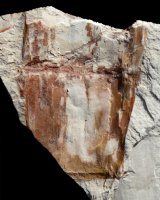Horsetails from Bayreuth
Neocalamites lehmannianus

From this horsetail mainly casts of the central cavity of the thick stems
have been found, as well as rhizomes (underground stems with roots at the
nodes). The diameter of the stems is mostly about 3 - 5 cm and the length
of the stem parts between two nodes is about 12 - 15 cm. It was a tall plant
and it branched only rarely. The leaflets are (as in all plants of this group)
placed in whirls on the nodes and they are free from each other up
to the base. The stems have a very fine longitudinal striping. |
Schizoneura
carcinoides
From this plant, on the contrary, mostly stems with leaves have been found.
The leaflets of a whirl are in most cases divided into two groups and they
are free from each other upto the base or connected by a thin rim. The leaflets
are about 3 mm wide and they can reach a length of 10 cm, being usually shorter.
The difference with the preceding species is simple: thick stems without
leaves or with loose small leaflets is Neocalamites, thin twigs with
clear whirls of long leaflets are Schizoneura. |
Equisetites muensteri

has rather thin stems (up to 3 cm, mostly 2 cm) with a wider longitudinal
striping than Neocalamites. There are clear leaf sheaths with long
teeth, which are connected at the base. Sepp and Traute Hauptmann (1994)
have given an excellent reconstruction of this plant in the Fossilien magazine.
|
Top |